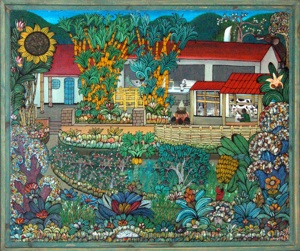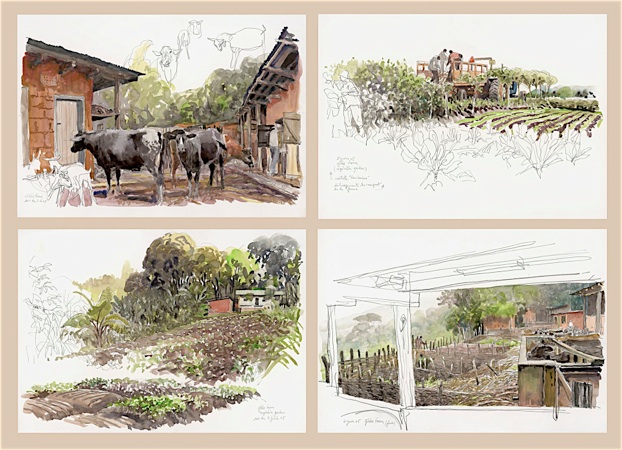The Shamba House at Gibb’s Farm




James Gibb purchased this coffee farm in 1948 and married Margaret in 1958. In 1970 the Conservation Area was established and because the farm bordered the conservation area, there was an influx in visitors to the region. In the early 1970’s, James and Margaret Gibb opened a few traveler rooms to accommodate this growing number of visitors and so began the legacy that is today’s Gibb’s Farm.
Robert Aswani’s (1) ‘Shamba’ painting captures the garden complete with the gardeners who tend to the fruits and vegetables that provide most of those served at Gibb’s Farm. Robert is a SANAA artist-in-residence. The vegetable garden tour is the perfect opportunity to explore the garden and the various methods used to ensure the organic nature of the fruits and vegetables. For example, instead of pesticides, Gibb’s Farm uses a combination of ash and oil that repels various insects. Travelers also notice that certain plots of the garden alternate rows of two different vegetables such as the alternating rows of lettuce and leeks. This is a form of pest management. If there is a certain pest that attacks lettuce, they are more likely to attack the leaves of the leeks first because they are taller and more readily available to pests,thus preserving the leaves of the lettuce and sacrificing the leaves of the leeks, which tend not to be used for cooking.
Riziki Kateya,, a SANAA artist-in-residence, captures the beauty that exists in the garden such as the flower that blooms from a pumpkin plant (2). Riziki specializes in botanical illustrations that have scientific purposes as well as artistic appeal. Riziki was chosen by botanist Colin Watkins to study at Kew Gardens in the Botanical Illustrations Department and train under Christabel King. Riziki explains the importance of accuracy in her illustrations, “Every detail, down to the minute hairs on a stem or the veins on a leaf, must be accurate. If I make a mistake, or the wind blows and the flower moves, I can’t paint over it; I have to abandon the painting and start over.” The slightest mistake in one of Riziki’s botanical illustrations could result in the misidentification of the plant; accuracy is essential in her profession.
The other important facet of Gibb’s Farm is the farmyard. Travelers may have seen or heard the cows or even have participated in milking a cow, which happens every morning at 7:30am and every evening at 4:30pm. The farmyard also provides a link to the local village of Tloma and surrounding communities. Instead of purchasing chicken, eggs, cows, and pigs from commercial suppliers, Gibb’s Farm has chosen to form relationships with the staff and surrounding communities for the purchasing of such livestock. This process helps support the local economy as well as cements the ties Gibb’s Farm has with its staff and community.
David Mzuguno, a SANAA artist-in-residence, captures this daily rhythm in ‘Farm Life’ (3). Farming and livestock are very important to the various culture groups in the area. The Iraqw grow maize as their staple crop, which can be used for ugali, a stiff porridge. Sweet potatoes, legumes and similar crops are also grown for sustenance. Cattle are also important to the Iraqw culture as they are used to plow the fields. Examples of traditional farm tools can be found in the Shamba House (below).
Cattle are also used as an indication of wealth. A cattle loaning system has been created within the Iraqw culture that serves to establish ties within and outside the family as well as reduce the risk of disease among the cattle. The Maasai on the other hand do not put much stake in agriculture, but rather focus all of their energy on their cattle. Cattle are significant to the Maasai as they are considered a gift from God, or Enkai; every part of the cow has a purpose for the Maasai and they are much loved and protected. Maasai settlements are constructed so that the cows are herded into the middle of the settlement at night for protection.
Cows are also used as a form of currency in Maasailand. For example, if someone in Maasailand goes to a doctor for treatment, they pay the doctor in cows. The number of cows they pay with is determined by their satisfaction of the treatment. The African Living Spa at Gibb’s Farm has tried to recreate a representation of this “cow-exchange” on its spa treatment payment form. After a traveler has received a treatment from our traditional Maasai healer, Dr. Labiki, they choose on the payment form how many “cows” they would like to give based on their satisfaction.
By scheduling a village walk or a walk to the farm estate’s lower waterfall, travelers can be exposed to some of the cultural beliefs mentioned above. The village walk takes travelers through the local village of Tloma where they can view traditional and modern houses complete with gardens and livestock. They will also be able to view a local school and brick-making factory. The walk to the lower waterfall gives travelers an opportunity to view from afar the Maasai Boma inhabited by the three Maasai employees of Gibb’s Farm that tend to the grazing of the cattle near their settlement.
The simple sculpture on the left by Charles Bies, a SANAA artist-in-residence, is titled ‘Shamba’ (4) depicts the simple activities performed on the Shamba, such as Gibb’s Farm and Tloma.
The activities at Gibb’s Farm are conducted with the purpose of exposing travelers to the various cultural and environmental facets that have shaped and continue to shape this region. They are designed to put into context the various things travelers are seeing and experiencing during their safaris. Cow milking occurs twice a day. Naturalists generally conclude their walks in the vegetable garden at the Tembo Fire Box. These routine farm activities were captured (below) by French artist Denis Clavreu (5) when he was in residence in 2005.
(1) Robert Aswani, Shamba, acrylic on canvas, A Commission Sanaa work.
(4) Charles Bies, Shamba
(3) David Mzuguno, Farm Life, oil on wood, A Commissioned Sanaa work.

(5) While French artist Denis Clavreul was in residence 2005 he created a number of memorable pencil watercolors of the farm and nearby village life.
New Tourism & the Harmony Project, All rights reserved.
Copyright © 2004 - 2012
African Living Spa, and Living Spa ® are registered/trademarked.


(2) Riziki Kateya, Pumkin, off-set lithography from water color original in the Sanaa Gallery collection. A Commissioned Sanaa work.


Iraqw style traditional shamba farm implements.



Sanaa Art Gallery Collection installed in each cottage. Select works have been commissioned to carry the theme and lesson of the house.



-
Other Gibb’s Farm web-links:


